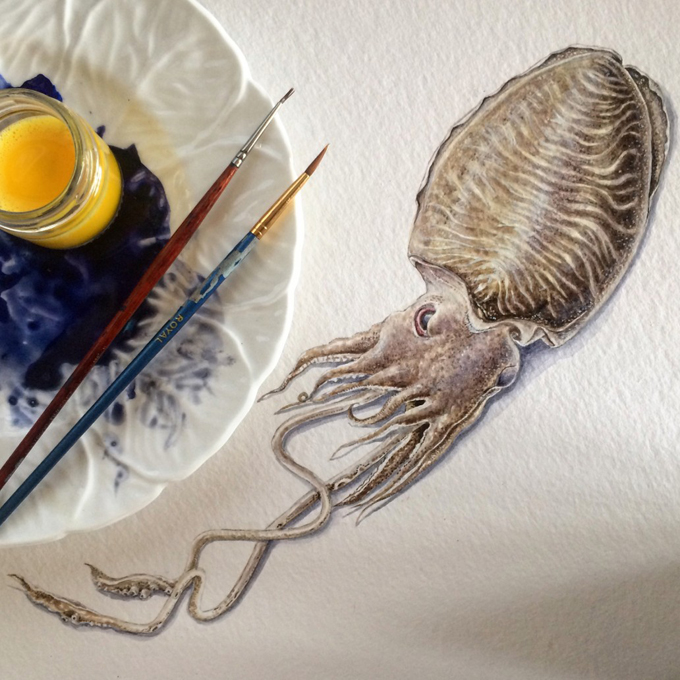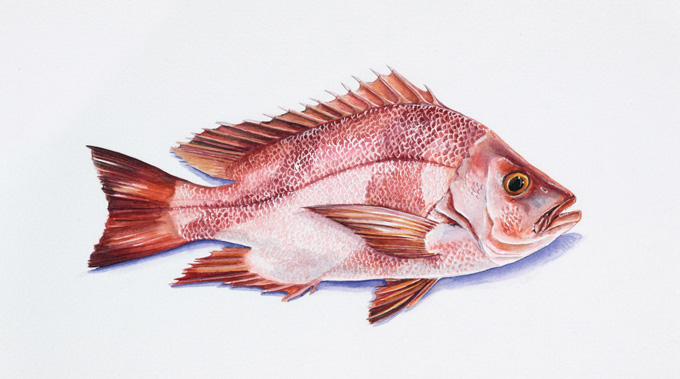Artist Interview – Anna Koska
Specialising in fruit, vegetables and the natural world, Anna has illustrated over 100 books and worked with chefs, writers and publishers from around the globe.
Over her 25 year career Anna has honed her skills in watercolour, pen & ink, oils and most recently, egg tempera. Her methods may vary but the joy of her artwork is constant; each piece she creates is a celebration of the fruit, vegetable or animal she has captured with her inimitable flare.
Anna achieves all of this against a backdrop of rural living, all recorded in her daily instagram post, which her 5,000 plus followers have come to adore. Her illustration work is inextricably linked with her way of life, Anna meets the ups and downs of a self sufficient lifestyle with a smile, embracing each challenge as it comes. An attitude she has also applied to her illustration career.
Constantly evolving, honing her craft and listening to the market, Anna's determination has secured her place as one of the UK's leading natural history illustrators. We spoke with Anna about the beauty of working traditionally, her seemingly idyllic lifestyle and the joy she gets from her work.
How did you become a professional illustrator?
Having not had any formal training in art, it was very much an organic process. As I didn't choose to study art, it wasn't a forgone conclusion that I would be an illustrator, it was something I came back to, when I felt the time was right.
I pulled a portfolio together, and I got this wonderful bit of advice from a lady who worked at Penguin. She said, 'your portfolio is slapped together with huge enthusiasm, I can see you can do lots of different styles but you're not going to find it very easy to get work because people like to be able to focus on one style. If you want to be remembered, and therefore be first in mind for a commission, you have to be able to leave that one thing in people's minds and not confuse the message.'
I thought that was great advice. I had everything, literally everything, in my portfolio; pen and ink, pencil, pastel, watercolour and every subject matter you can imagine; cartoons, landscapes, children's illustrations. You name it, I'd squeezed it into this poor little portfolio.
I went away and took about 80% of my work out and replaced it with food and natural history illustrations, all in watercolour. I got a job within a month and never stopped working from that point onwards.
Could you talk a little about your working process. When you get a commission, how do you approach the project?
To start with, I want to find out more about the author, I read up on them. I wouldn't necessarily go and buy all their books, because I think that's over egging the omelette, if you'll pardon the pun, because obviously they are looking to you as the illustrator to provide something that's different from their other books. But, most authors still want a level of continuity so it's important to understand where they've been and therefore what they are looking for.
The designer is vital in the process. I always make sure I understand exactly what the brief and their vision is before I even shuffle a paper onto the desk. In terms of producing the work, I do everything by hand and then I scan it in and ping it over.
Do you find it challenging working purely by hand in this digital age?
Really it's all down to the client understanding the process. I do think working by hand makes everybody take a step back and focus on what's actually wanted rather than dashing out ideas randomly. Digital definitely has it's place; it's fabulous, it's quick, but you know speed isn't always the best.
Your Instagram account paints a beautiful picture of your life. How have you used it in terms of your illustration career?
I use instagram as a platform to talk with friends and clients. With all social media I stick to being me. That includes warts and all, and because instagram is purely photographic, it reflects what my lifestyle is, and people seem to respond very kindly to that.
I also used twitter and instagram to find my feet again after having my children. By watching what was going on I could see what people were really enjoying, so I started to find a place for myself. The people I connect with are constantly adding a fresh view to what I'm doing.
From the pictures you post you look to be almost self sufficient, is it as idyllic as it looks?
There are loads of challenges. Out of shot, both physically and mentally. You've got the chaos of running a home with three teenagers, chickens that walk in the house, foxes that eat them and last year we had pigs as well that kept on escaping. I also keep bees and I get stung pretty much on a regular basis throughout summer, and throughout the warmer months I'm usually caked in mud from the veg garden. Life could be portrayed as being idyllic, but it's funny and everything gets cocked up and things never really go according to plan. You just kind of sail along with it, rather than going down with it. It's very much Tom and Barbara of The Good Life.
Would you say there is a great synergy between your home and work life?
It's very much that way, my illustration is so intertwined with the way I was brought up and the way we live our lives now. I think because I've never had any formal training, my art hasn't defined me. It's just part of me and it is very much part of the whole set up here and how we live.
What are your favourite things to draw?
Figs! Whether it's cut open or split because it's too full with ripeness. All the food I draw is raw, because food doesn't look any better than when it's raw. Also, I love painting cephalopods; the octopus, squid and cuttlefish family. Mussel's are another favourite to portray, it's that dip and curve, that beautiful butter knife sharpness as you run your thumb along the edge. When I paint, I suppose what I'm trying to paint is what something feels like in the hand.
With all my paintings it's that voluptuousness and sensuous quality that I find utterly intriguing. So although I may be illustrating food, it's not necessarily because it's food, it's because I love the look of it. It's all about the look and the emotion it evokes.
Do you eat everything you paint?
Yes, it's a rare thing if I'm painting a food that I haven't eaten. I'm usually about to eat it or I will eat it, once I've finished painting it. I usually work from life and if the thing that I'm working from is likely to rot down, particularly fish, I'll take many reference photographs and if it gets past the point of looking good I'll cook it. I'll often freeze fish, to bring out and refer back to when needed.
You've had an incredibly successful career, what would you say is the key to your longevity?
Well, having popped out the children, coming back to illustration was literally like starting again, so it actually gave me that chance to have a fresh look at what I wanted to do and where to place myself. I could see that the gap was still there, but in that eight year period photography had really taken over and nobody wanted illustration. I could see I was going to have to work very hard to create a demand, not just for food illustration in general, but for my work because no one in my industry knew me anymore.
Discovering new mediums to play with is a vital part of being an illustrator for me. It keeps me learning and growing. Playing with egg tempera is one such example. It's an ancient medium and it's been fun to work with and add a modern twist. I think wanting to have a go and being willing to learn new stuff has helped tremendously.
What advice would you give a young illustrator?
Firstly I hate giving advice, as it suggests I'm at a stage in my life where I've got everything worked out. I really don't feel like that at all! I'm continually learning. But, I'd say that listening to the people around you is key. It's funny how one lady's bit of timely advice was so monumental for me at the beginning of my career. I could have just ignored it and gone back to temping. It's very easy to have your confidence knocked in the creative field as it's so subjective, you can listen to someone else's opinion and it can take the wind right out of your sails or it can fill your sails and push you onwards. So good creative advice is like gold.
I've always felt it is an honour and a privilege to produce someone's artwork, you are working with an author or a designer's precious idea. There's a huge amount of trust there. I think if you view all work that way, you can't really go wrong.
Anna Koska is represented by Meiklejohn








